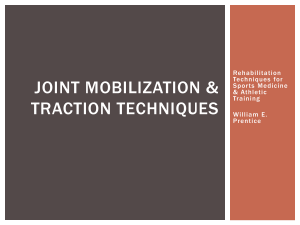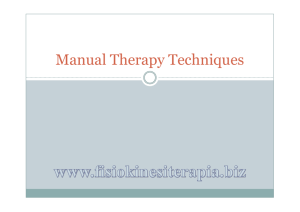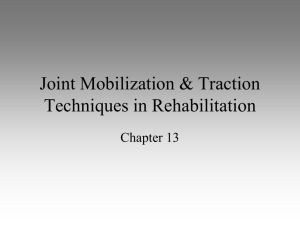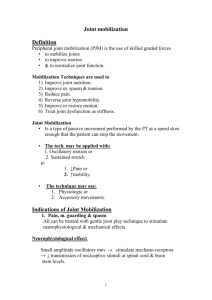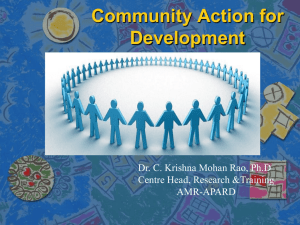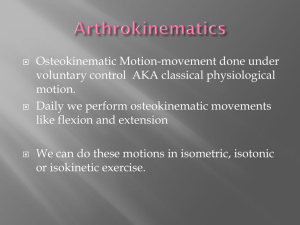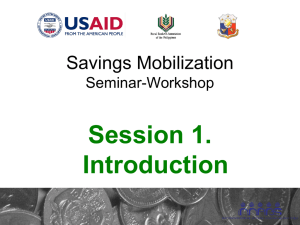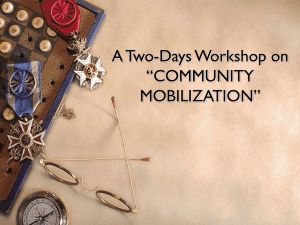Chapter 14: Joint Mobilization and Traction Techniques
advertisement
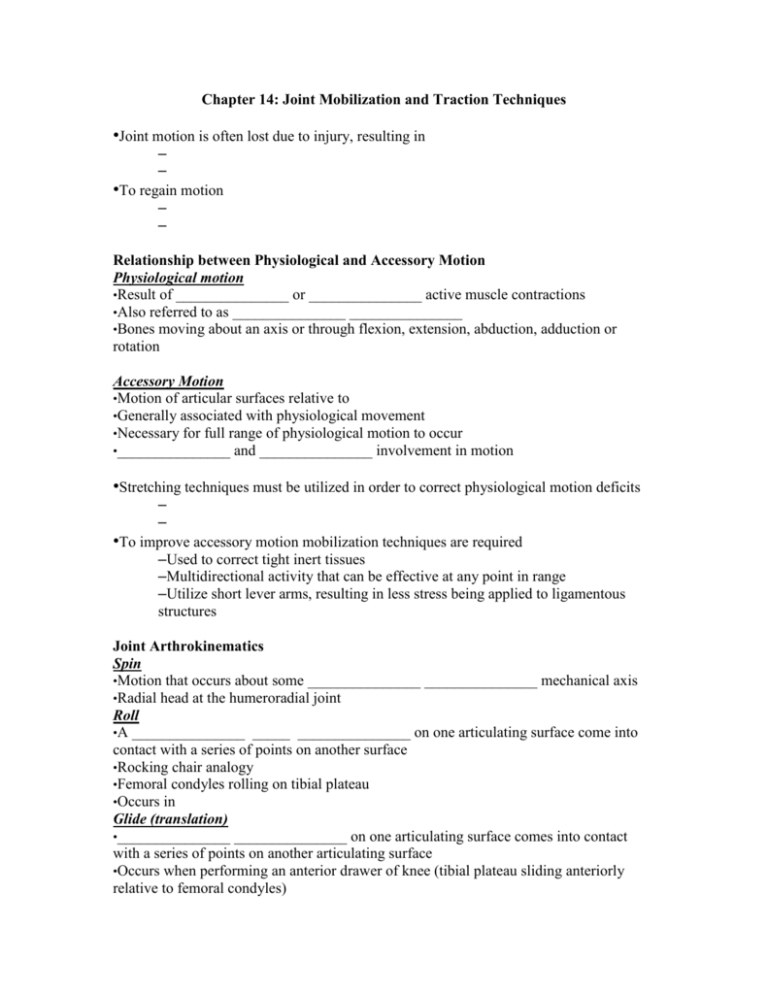
Chapter 14: Joint Mobilization and Traction Techniques •Joint motion is often lost due to injury, resulting in – – •To regain motion – – Relationship between Physiological and Accessory Motion Physiological motion •Result of _______________ or _______________ active muscle contractions •Also referred to as _______________ _______________ •Bones moving about an axis or through flexion, extension, abduction, adduction or rotation Accessory Motion •Motion of articular surfaces relative to •Generally associated with physiological movement •Necessary for full range of physiological motion to occur •_______________ and _______________ involvement in motion •Stretching techniques must be utilized in order to correct physiological motion deficits – – •To improve accessory motion mobilization techniques are required –Used to correct tight inert tissues –Multidirectional activity that can be effective at any point in range –Utilize short lever arms, resulting in less stress being applied to ligamentous structures Joint Arthrokinematics Spin •Motion that occurs about some _______________ _______________ mechanical axis •Radial head at the humeroradial joint Roll •A _______________ _____ _______________ on one articulating surface come into contact with a series of points on another surface •Rocking chair analogy •Femoral condyles rolling on tibial plateau •Occurs in Glide (translation) •_______________ _______________ on one articulating surface comes into contact with a series of points on another articulating surface •Occurs when performing an anterior drawer of knee (tibial plateau sliding anteriorly relative to femoral condyles) •Pure gliding requires _______________ _______________ •Direction of movement determined by _______________ of articulating surface Joint motion will often involve a combination of these components Convex-Concave Rule •Relationship of articulating surfaces associated with _______________ •If concave joint is moving on _______________ convex surface – glide occurs in same direction as roll •If convex surface in moving on stationary _______________ surface – gliding occurs in opposite direction to roll •Necessary to understand in order to determine appropriate treatment direction Joint Positions •Resting position –_______________ joint play-position in which joint capsule and ligaments are most relaxed –_______________ and _______________ position utilized with _______________ joints •Loose-packed position –Articulating surfaces are _______________ _______________ –Joint will exhibit _______________ amount of joint play –Position used for both _______________ and _______________ _______________ •Close-packed position –_______________ contact of articulating surfaces •Mobilization and traction utilize translation movements of joint surfaces relative to one another •Treatment occur _______________ or _______________ to treatment plane •Mobilization techniques involve glides that translate along the treatment plane •_______________ – moves perpendicular to treatment plane Joint Mobilization Techniques •Used to improve joint mobility or decrease joint pain by restoring accessory motion •Used to attain mechanical or neurophysiological treatment goals – – – – •Facilitate muscle tone or stretch reflex – •Accessory motion can be_______________, _______________l, or _______________ •Joints have range with anatomical limits (bony and soft tissue) •With hypomobile joints, motion stops at point short of anatomical limits – •Hypermobile joint move beyond anatomical limits – –Treat with •To restore motion in hypomobile joints ______________ _______________ must occur •Tissue stretch within _______________ range does not produce permanent structural change •Stretching in _______________ range cause permanent structural changes •Traction and joint mobilization can be used to stretch tissue and break tissue adhesions •Treatments generally involve slow, small amplitude movements –Joint mobilizations involve small amplitude oscillations Maitland Joint Mobilization Grading Scale •Grade I –Small amplitude movement at the _______________ of the range of movement –Used to manage _______________ and _______________ •Grade II –_______________ amplitude movement within _______________ of movement –Utilize when quick oscillation induces _______________ or when slowly increasing pain restricts movement halfway into range •Grade III –_______________ amplitude movement up to point of limitation (PL) in the range of movement –Used when pain and resistance from spasm, inert tissue tension, or tissue compression limit movement near end of range •Grade IV –_______________ amplitude movement at very end of range –Used when resistance limits movement in absence of _______________ •Grade V –_______________ amplitude, quick thrust at _______________of range –Accompanied by popping sound (manipulation) –Velocity vs. force –_______________ _______________ •All joint mobilizations follow the convex-concave rule •If mobilization in the appropriate direction exacerbates pain or stiffness the technique should be applied in the opposite direction until tolerance to the appropriate direction is achieved •Joint mobilization sessions usually involve 3-6 sets of oscillations lasting 20-60 seconds, 1-3 oscillations per second Indications for Mobilization •Grades I and II are used primarily for _______________ •Grades III and IV can be utilized for _______________ •Pain must be treated prior to _______________ •Small amplitude oscillations are utilized to stimulate mechanoreceptors, limiting pain perception •Painful conditions can be treated _______________ •Stiff or hypomobile joints should be treated _______________ times per week – alternate with active motion exercises •Pain prior to resistance being applied – •Pain elicited upon resistance to motion applied – •Resistance application prior to indication of pain – •Athlete and athletic trainer must utilize appropriate positioning to ensure safe and effective treatment Contraindications for Mobilization •Should not be used haphazardly •Avoid the following –Inflammatory arthritis –Malignancy –Bone disease –Neurological involvement –Bone fracture –Congenital bone deformities –Vascular disorders Joint Traction Techniques •Technique involving _______________ one articulating surface away from another – creating _______________ •Performed _______________to treatment plane •Used to _______________ _______________ or _______________ _______________ _______________ •Kaltenborn classification system –Combines _______________ and _______________ Kaltenborn Traction Grading •Grade I (loosen) –Neutralizes pressure in joint without actual surface separation –Produce pain relief by reducing _______________ _______________ •Grade II (tighten or take up slack) –Separates articulating surfaces, taking up slack or _______________ _______________ within joint capsule –Used initially to determine joint _______________ •Grade III (stretch) –Involves stretching of soft tissue surrounding joint –Increase _______________ in _______________ joint •Grade I traction should be used initially to reduce chance of painful reaction •10 second intermittent grade I and II traction can be used •Distracting joint surface up to a grade III and releasing allows for return to resting position •Grade III traction should be used in conjunction with mobilization glides for hypomobile joints –Application of grade III traction (loose-pack position) –Grade III and IV oscillations within pain limitation to decrease hypomobility
